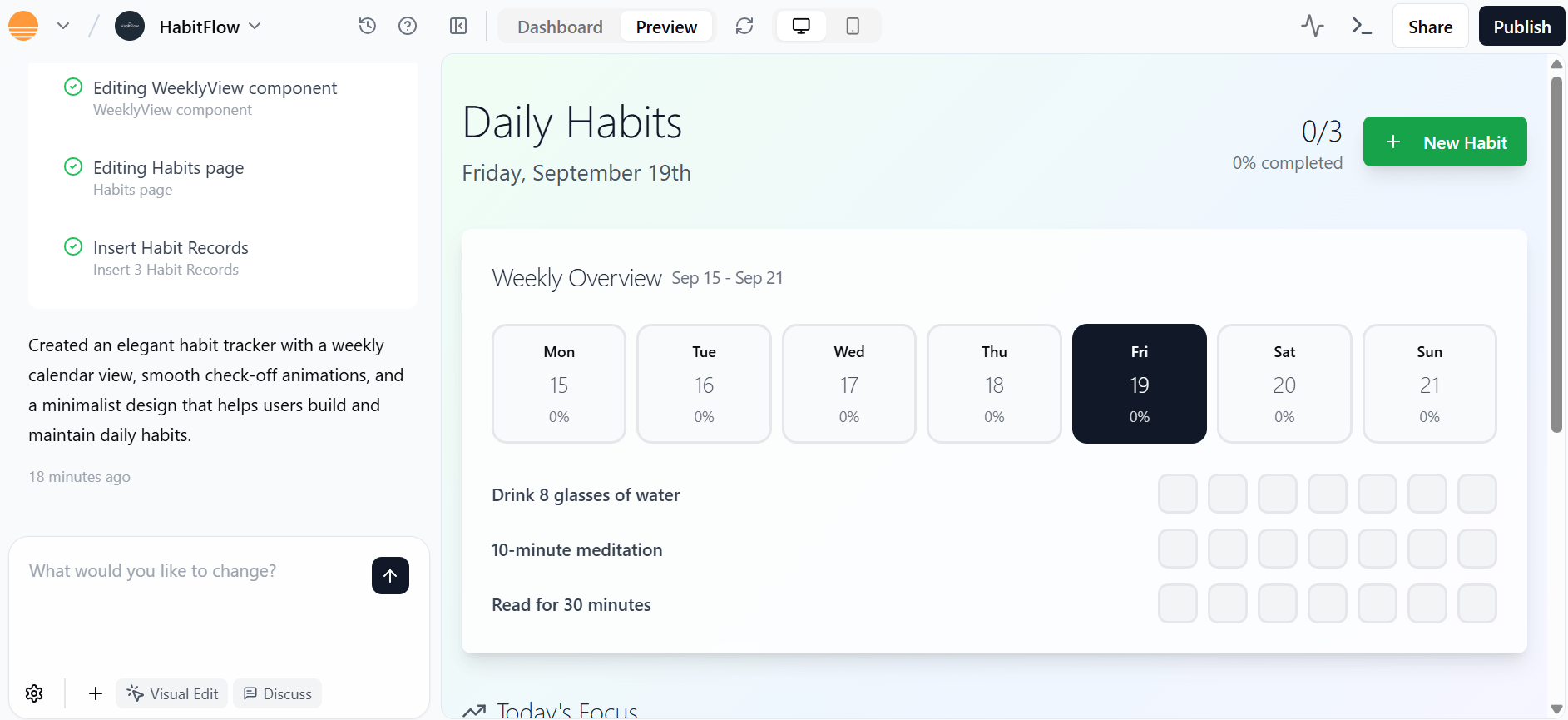We may receive a commission from our partners if you click on a link to review or purchase a product or service. Click to Learn More
Vibe coding is a software development practice that uses an AI chatbot-like workflow to transform natural language prompts into functional code, allowing you to build apps from scratch without writing a single line of code.
Despite only being introduced in 2025, vibe coding platforms like Base44 are already revolutionizing the way individuals and businesses create software. With app-building no longer being reserved for expert coders, the practice is democratizing opportunities, helping users create anything from personal ‘one-off’ projects to scalable, internal company software in a matter of minutes.
If you’re interested in using AI to fast-track the coding process, this deep dive covers everything you need to know about vibe coding, including what it actually means, how it differs from normal coding, and which platforms you can use to get started.

What is Vibe Coding?
Vibe coding is a fresh take on coding, which allows users to focus on their high-level vision instead of writing and reviewing lines of code.
The intuitive approach uses AI to transform natural language prompts into executable code, with the goal of streamlining the development process and making the practice accessible to individuals with less technical experience.
Vibe coding was first introduced in February 2025 by prominent computer scientist and co-founder of OpenAI, Andrej Karpathy. He coined the term in a post on X, and named the practice “vibe coding” because it involved guiding the AI with the general “vibe” of a project, rather than traditional line-by-line programming.
How Does Vibe Coding Differ From Normal Coding?
While the end goal is similar, vibe coding and traditional coding represent two fundamentally different approaches to software development. While traditional coding is a meticulous, hands-on process that involves manually writing each line of code, vibe coding is an AI-powered, top-level process that only requires users to describe their desired outcome.

Base44 let me create a habit tracking app from a natural language prompt. Source: Tech.co
With vibe coding, the AI handles complex tasks of writing and editing code, leaving the user to focus on other strategic tasks, like running tests and improving the app’s functionality. However, this slicker user experience does come with tradeoffs.
Traditional coding gives you complete control over every aspect of what you’re doing, right down to the smallest changes. As a result, the code is typically more robust, secure, and scalable. The downside, of course, is that this takes time – not just the coding itself, but the years of technical experience you’ll have to acquire to know what you’re doing.
Vibe coding, on the other hand, can sometimes produce poorly optimized code that human developers would be able to catch, simply because it’s more top-level. The big upside, however, is the low barrier to entry, and the fact that anyone who can write a prompt can create a complex application.
Examples of Vibe Coding Projects
Vibe coding’s low barrier to entry has already helped countless users transform concepts into fully working applications.
Platforms like Base44 are being used to bring creative personal ideas to life. For example, Reddit user RobleyTheron used the platform to create Drinkzly – a beverage tracking app which allowed them to rate their favorite alcoholic beverages, and add photos.
Vibe coding platforms are also being used for professional purposes. For example, Reddit user Fearless-Change7162 used Base44 to create seoaistudio.com – an SEO analysis app which gives recommendations for RAG-based content generation.
The prompt-based coding method has also enabled companies to create custom applications in a couple of clicks, from project management to time tracking tools, showcasing the versatility of the coding method. You can even whip up a brand new website with vibe coding.
These varied use cases suggest that, no matter how niche your idea, you’ll be able to bring it to life with vibe coding — the limit really is your imagination.
Vibe coding will be right for you if:
- You need to build a prototype to quickly test an idea
- You prioritize speed and ease over granular control
- You want to develop a simple app for personal use
- You want to develop a workplace solution without hiring a full development team
You’d be better off using traditional coding if:
- Your project is highly complex and requires specialized functionality
- You have the budget to invest in a full development team
- The app you intend to design will handle highly sensitive data
- You want full ownership of your codebase without relying on a third-party ecosystem

How to Get Started with Vibe Coding
Interested in seeing what vibe coding can do for you? Getting started is surprisingly straightforward, especially if you’re already familiar with tools like ChatGPT or Gemini. Hit the ground running by following these simple steps:
- Come up with a clear vision – You need to have a clear idea of the app’s core purpose, features, and target user.
- Craft your initial prompt – Describe your app with as much detail as possible. Structure the prompt with context, the task, and important details.
- Refine your app – After you get an initial preview of your app, edit it using the chat feature until you’re happy with the result.
- Test your app – Once you’ve refined your app, deploy it to the web and share it with your wider network using the public URL.
Vibe coding may still be in its infancy, but several platforms are already leading the charge. Base44, for example, which we mentioned earlier on, is a full-stack AI-driven app builder that allows you to create complete applications from natural language prompts alone.
It lets you access the platform’s core features for free, but to unlock more generous message and integration credit limits and backend features, you’ll have to upgrade to one of its paid plans, which start from as little as $16 per month.
If you click on, sign up to a service through, or make a purchase through the links on our site, or use our quotes tool to receive custom pricing for your business needs, we may earn a referral fee from the supplier(s) of the technology you’re interested in. This helps Tech.co to provide free information and reviews, and carries no additional cost to you. Most importantly, it doesn’t affect our editorial impartiality. Ratings and rankings on Tech.co cannot be bought. Our reviews are based on objective research analysis. Rare exceptions to this will be marked clearly as a ‘sponsored’ table column, or explained by a full advertising disclosure on the page, in place of this one. Click to return to top of page